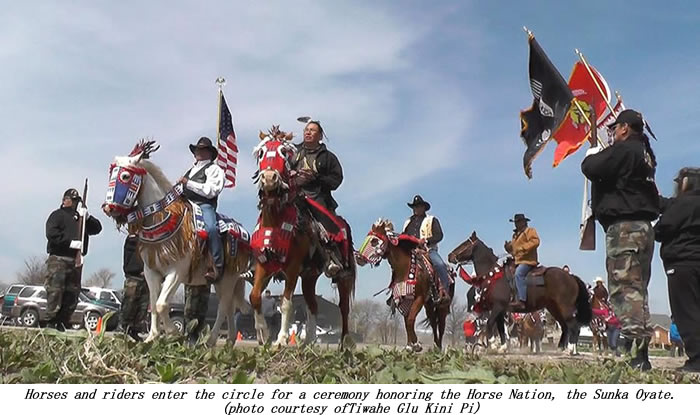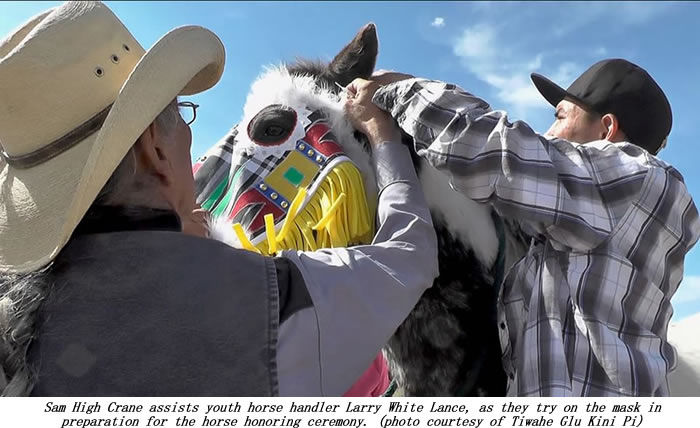 |
Canku Ota
|
 |
|
(Many Paths)
|
||
|
An Online Newsletter
Celebrating Native America
|
||
|
November 2014 - Volume
12 Number 11
|
||
|
|
||
|
'Horse Nation' Documentary
Explores
Lakota Culture, Horse Relatives |
||
|
by Christina Rose -
Indian Country Today Media Network
|
||
|
"People tend to think of us as buffalo people, but really, we are horse people, too. That got lost and is coming back, and we want to document that," said Jim Cortez, the film's editor of "We Are A Horse Nation."
The trailer for "We Are A Horse Nation" has audiences calling for more. Still photographs from the film prove there is plenty to look forward to in this new documentary. Now in its final production stages, "Horse Nation" is expected to be completed by November for entrance into film festivals. The film is the result of the efforts of Keith Brave Heart, social marketing manager of Tiwahe Glu Kini Pi, and Jim Cortez, who heads the media department at Sinte Gleska University in Rosebud, South Dakota. They started shooting the documentary last winter. "We wanted to have a film that was told by the people—from the little kids all the way to elders—with all of their different stories about what the horse as a relative means to them. We wanted a film that stays away from the poverty porn, that has a good sense of humor. We wanted to show the profound beauty and the spirit that is still here; it's about the horse and the people whose lives are touched by them," Cortez said. "The relationship with the horse changed with the boarding schools," Brave Heart said. "The cowboys were "breaking" horses, and it became a time when we were being broken ourselves. Now we see the honoring Memorial Rides, the Dakota 38 plus two, Wounded Knee, and you can see that people are bringing the horse back to the homelands."
Brave Heart began this filmmaking journey after watching the young horse handlers at Sinte Gleska University's Tiwahe Glu Kini Pi program, "Bringing the Family Back to Life." The program serves children, ages 3 to 21, and is held at the university's SGU Ranch on the Rosebud Reservation. "I wanted to put together a film that would follow the youth horse handler on their journey working the horse. I was going to document the program and our system of care, but I also wanted to see something good and entertaining," Brave Heart said. Because he understood the wakan (spiritual and sacred) relationship between the horse and the Lakota, Brave Heart expanded the film into multiple stories. "The Oceti Sakowin, or Lakota, Dakota, and Nakota, are all from the horse nation. I traveled to all the reservations in South Dakota to see what they wanted to share about the history of the horse and their traditional stories," Brave Heart said. Concerned about the way outsiders view the reservations, Brave Heart said, "We are not just about poverty and alcoholics. I wanted to see a story told from the Oceti Sakowin perspective. This is an opportunity to see the positive stories. We still have our culture." Playing a critical role both in the documentary and in the lives of the youth in therapy, Sam High Crane, youth coordinator with Tiwahe Glu Kini Pi, and elder, cultural mentor and advisor, has worked much of his life with horses and youth. Years ago, he developed the Lakota history and culture curriculum, including horses and traditions, for the Saint Francis School in Rosebud. "I would see how horses would react to kids who had problems and I told the kids, 'Look what the horse is doing,' and, 'Why do you think this is happening?' They had to take a look at themselves and change their ways. Working with the horses worked."
"Even for my own issues, sometimes I ride my horse way out in the boonies and lead my own ceremony, offer tobacco, and talk to the horse. If we are worried about confidentiality," High Crane laughed, and acknowledged that a horse can keep a secret. The film celebrates the relationship between the Lakota, Dakota, and Nakota nations and the Sunkawakan Oyate (Horse Nation) and includes an honoring ceremony with regalia for the horse. "At one time in Lakota and Dakota history, the use of horse regalia was commonly practiced. Unfortunately over time, this practice has become almost obsolete," reports artist James Star Comes Out. Doing his part for the program, Star Comes Out had the youth develop designs for the horse masks and regalia used in the film. Some of those masks became part of a giveaway during the summer's honoring ceremony. The film takes place where the clinical world meets the wakan. Marlies White Hat, director of the Tiwahe Glu Kini Pi program said that Equine Therapy is natural and comfortable for Lakota people. "The youth learn how to communicate. It is much easier to talk to a horse than to sit in a counselor's office," she said. In the film, the youth are seen working with the horses and expressing themselves in various ways. "They may paint their feelings on the horses," White Hat said. "We have paints and brushes, and we also have activities that teach lessons based on Lakota values." "We spend all this money training people how to get well, and all this time we had these horses and never used them to fix the issue," High Crane said. "I truly believe we are not perfect, and if you hang around the horse, you will find your mistakes." "It was not about us being master cinematographers. It is just about the people being truthful. There are no actors, it's real life—and why I believe it is so good," Brave Heart said. Cortez agreed. "We wanted to find the ikce oyate, the common people, not the usual spokespeople, but the ones who rarely get to tell their story. We traveled around and we wanted to encourage people to know, you just have to stand up and do this." When the film is complete, Brave Heart envisions taking the film back into all of those communities. "They will get pride by hearing these stories in their home," he said. The film was produced with funding through by Substance Abuse Mental Health Services Administration/ Child Mental Health Initiative, and the help of many volunteers including Cortez and musicians Keith Secola and Cody Blackbird. "We also have artwork from Oscar Howe, and artist Donald Montileaux explains about ledger art. Marlena Miles is doing graphic art, so we are bringing some recognition to their artwork," Brave Heart said. He added, "We are just common people, honoring each other, each of the Oyate (people) of the Oceti working together as relatives. I am just happy working on this project. Looking at footage, it makes me appreciate our elders. We need to make this happen so the youth can know these things, to have an initiative to know more. The youth is the reason to do this, to take pride in their history and culture, learn from the elders and carry on." To follow the film's news and to see more photos, visit "We Are A Horse Nation" on Facebook. See the extended trailer below: "We
Are A Horse Nation" Tiwahe
Glu Kini Pi |
 |
|
|
||
|
|
||
| Canku Ota is a free Newsletter celebrating Native America, its traditions and accomplishments . We do not provide subscriber or visitor names to anyone. Some articles presented in Canku Ota may contain copyright material. We have received appropriate permissions for republishing any articles. Material appearing here is distributed without profit or monetary gain to those who have expressed an interest. This is in accordance with Title 17 U.S.C. Section 107. | ||
|
Canku Ota is a copyright ©
2000 - 2014 of Vicki Williams Barry and Paul Barry.
|
||
 |
 |
|
|
The "Canku
Ota - A Newsletter Celebrating Native America" web site and
its design is the
|
||
|
Copyright ©
1999 - 2014 of Paul C. Barry.
|
||
|
All Rights Reserved.
|
||


